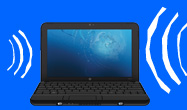PC Learning Center
Explore
Support & Drivers

Introduction
If you want to use your laptop PC to wirelessly connect to the Internet1 you have two options: WLAN2 (Wireless Local Area Networks) and WWAN3 (Wireless Wide Area Networks). But what’s the difference between the two? And which connection will work best for your needs?
A detailed look at both options

WLAN and WWAN both connect you to the Internet wirelessly, but they use different technology to do it. WLAN is intended for “local” use (the “L” in WLAN). Also referred to as Wi-Fi, it’s probably the most common way to wirelessly connect to the Internet. WWAN is a mobile broadband3 option that covers a “wide” area (the “W” in WWAN). You may have heard it called a “3G” or in some areas a “4G” network.
Comparison
Imagine the two wireless options as if they were phone connections instead of Internet.1 WLAN is like your home phone. You can use it as long as you’re in or around your house or wherever the WLAN router (“hot spot”) is located. It’s generally affordable, and if needed you can use a pay phone when you’re away from home.
WWAN, on the other hand, is like your cellular phone. You can use it anywhere you have coverage—in a car, an airport, or a sporting event. WWAN uses cellular service, provided by mobile operators, so it requires a monthly subscription fee or “session-based pricing.”
Local vs. wide area
Both connections have their advantages and downsides.
WLAN
+ Most computers come with WLAN technology built in
+ It’s easy and affordable to set up a WLAN network in your home using a router and Internet service provider (ISP)
+ WLAN connections are commonly found in homes, offices, hotels, coffee shops and airports and are sometimes free to use
+ WLAN keeps you constantly connected to your network as your move around your house or network area
+ With WLAN it’s easy for small businesses to grow and connect more users without adding wires
+ WLAN is typically faster than WWAN
– The area covered by WLAN is fixed and typically small
– Because WLAN uses radio waves, signal strength can sometimes be compromised
– When WLAN is not free, users must usually purchase usage in 24-hour increments, knowing they’ll often use only a few hours of that time.
WWAN
+ WWAN provides regional, nationwide and global wireless coverage
+ Insert the WWAN card from your service provider or even easier, select a notebook with built-in WWAN technology (such as an HP Mobile Broadband card) and then contract with a service provider
+ WWAN provides better security than WLAN thanks to built-in 128-bit encryption4
+ Utilize cellular technology to securely transfer data or connect to the Internet4
+ Ideal for users away from home needing to connect virtually anywhere in their coverage area
– ISP contract may cost more than WLAN for those who rarely need or use wireless Internet access
– Replacing a lost external WWAN card can be costly (a built-in version may be a better choice)
Which connection is right for you?

Home users – If most of your computing is done in your home WLAN is usually the best choice.
Students – Since most universities provide Internet service on their campus, WLAN may be the best option.
Travelers – If you’re constantly on the road for business or pleasure and can’t be without your web connection, WWAN is right for you.
Netbook users – HP Mini netbooks come with built-in WLAN capability2 but if you want Internet connections beyond hotspots, you may want to order an HP Mini with built-in mobile broadband.3
Getting started
If your laptop has a built-in wireless card all you need is an ISP, a modem (sometimes provided by the ISP) and a router.
Today’s HP mobile broadband laptops allow you to purchase a system with WWAN already built in. Or, for select models, you can add an after-market WWAN kit that is easily installed. You can connect to a WWAN network anywhere within your wireless carrier’s coverage map (Sprint, Verizon Wireless or AT&T in the U.S.).
- 1 Internet access is required; sold separately.
- 2 Wireless access point and Internet service required and not included. Availability of public wireless access points limited.
- 3 Broadband use requires separately purchased service contract. Check with service provider for coverage and availability in your area.
- 4 WWAN connections have built-in 128-bit encryption, so the risk of data interception, theft, and modification is significantly reduced. This is the same level of encryption used throughout the internet, and for governmental, banking, and military applications.